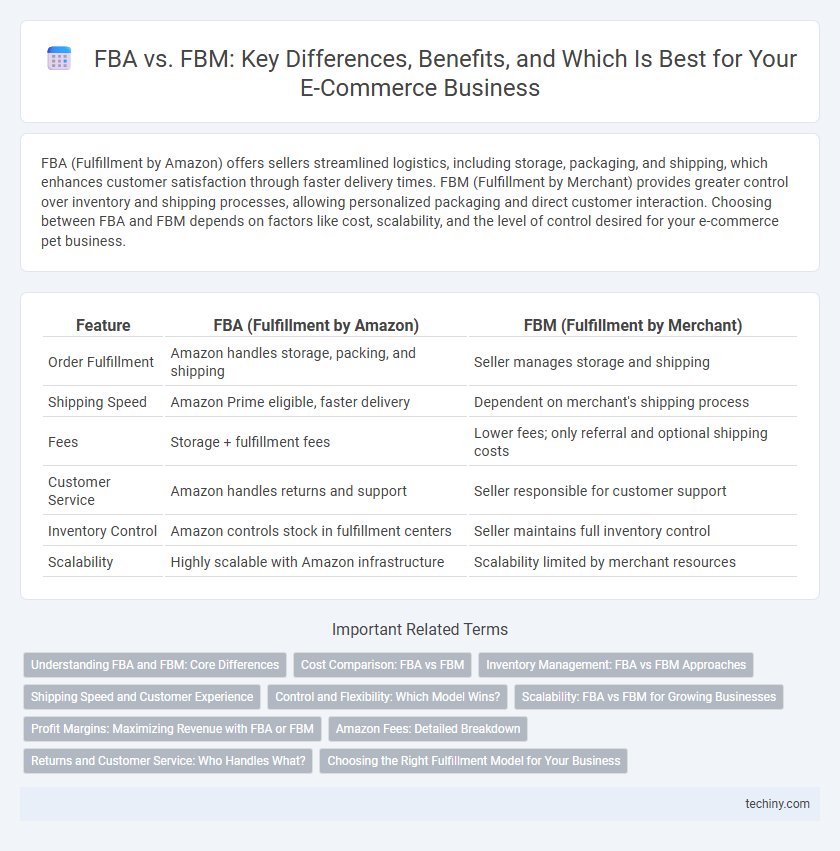FBA (Fulfillment by Amazon) offers sellers streamlined logistics, including storage, packaging, and shipping, which enhances customer satisfaction through faster delivery times. FBM (Fulfillment by Merchant) provides greater control over inventory and shipping processes, allowing personalized packaging and direct customer interaction. Choosing between FBA and FBM depends on factors like cost, scalability, and the level of control desired for your e-commerce pet business.
Table of Comparison
| Feature | FBA (Fulfillment by Amazon) | FBM (Fulfillment by Merchant) |
|---|---|---|
| Order Fulfillment | Amazon handles storage, packing, and shipping | Seller manages storage and shipping |
| Shipping Speed | Amazon Prime eligible, faster delivery | Dependent on merchant's shipping process |
| Fees | Storage + fulfillment fees | Lower fees; only referral and optional shipping costs |
| Customer Service | Amazon handles returns and support | Seller responsible for customer support |
| Inventory Control | Amazon controls stock in fulfillment centers | Seller maintains full inventory control |
| Scalability | Highly scalable with Amazon infrastructure | Scalability limited by merchant resources |
Understanding FBA and FBM: Core Differences
Fulfillment by Amazon (FBA) allows sellers to store products in Amazon's warehouses, with Amazon handling storage, packaging, and shipping, enhancing delivery speed and customer service. Fulfillment by Merchant (FBM) requires sellers to manage inventory, packing, and shipping independently, offering greater control but higher operational responsibilities. Understanding these core differences is crucial for e-commerce sellers to optimize logistics, costs, and customer satisfaction strategies effectively.
Cost Comparison: FBA vs FBM
Fulfillment by Amazon (FBA) typically incurs higher upfront fees such as storage, fulfillment, and long-term warehousing costs, while Fulfillment by Merchant (FBM) allows sellers to control shipping expenses and avoid Amazon's storage fees. FBM often reduces overall costs for sellers with efficient logistics but may increase time-to-delivery and customer service responsibilities. Analyzing order volume, storage needs, and shipping rates is essential for selecting the most cost-effective option between FBA and FBM.
Inventory Management: FBA vs FBM Approaches
FBA (Fulfillment by Amazon) streamlines inventory management by outsourcing storage, packing, and shipping to Amazon's network, reducing seller involvement and enabling faster delivery through Amazon Prime. In contrast, FBM (Fulfillment by Merchant) requires sellers to handle all inventory storage, order processing, and shipping, giving them full control over stock levels but demanding greater logistical effort. Effective inventory management in FBA reduces stockouts and overstock risks via Amazon's automated replenishment tools, while FBM sellers must rely on their own tracking systems to optimize inventory turnover and meet customer expectations.
Shipping Speed and Customer Experience
FBA (Fulfillment by Amazon) offers faster shipping times with Prime two-day delivery, enhancing customer satisfaction through reliable and expedited order fulfillment. FBM (Fulfillment by Merchant) depends on the seller's own logistics, often resulting in slower shipping and variable delivery experiences. Faster shipping speeds via FBA contribute significantly to higher customer ratings and repeat purchases in the competitive e-commerce market.
Control and Flexibility: Which Model Wins?
FBA (Fulfillment by Amazon) offers sellers less control over inventory and shipping processes, as Amazon manages storage, packaging, and delivery, ensuring fast Prime shipping but limiting customization options. FBM (Fulfillment by Merchant) provides greater flexibility and control, allowing sellers to handle inventory management, packaging choices, and shipping strategies tailored to their brand and customer needs. Sellers prioritizing control and personalized customer experiences often favor FBM, while those seeking efficiency and scalability lean towards FBA.
Scalability: FBA vs FBM for Growing Businesses
FBA offers superior scalability for growing businesses by handling inventory storage, packing, and shipping, enabling sellers to focus on marketing and product development. FBM requires sellers to manage fulfillment logistics themselves, which can become a bottleneck as order volumes increase. Leveraging FBA's extensive fulfillment network allows businesses to efficiently scale operations without proportional increases in overhead costs.
Profit Margins: Maximizing Revenue with FBA or FBM
FBA (Fulfillment by Amazon) often results in higher profit margins due to Amazon's efficient logistics and increased buy box eligibility, boosting sales velocity. FBM (Fulfillment by Merchant) provides greater control over shipping costs and inventory management, potentially lowering expenses for sellers with streamlined operations. Analyzing customer demand, product size, and handling costs is essential to determine which fulfillment method maximizes revenue and overall profitability.
Amazon Fees: Detailed Breakdown
Amazon FBA fees include fulfillment fees based on product size and weight, storage fees charged monthly depending on inventory volume, and additional costs for long-term storage, removal, or returns processing. FBM sellers pay lower Amazon fees but incur higher expenses for shipping, packaging, and customer service, as these are handled independently. Understanding the fee structure of FBA and FBM is critical for optimizing profit margins and pricing strategies in Amazon's marketplace.
Returns and Customer Service: Who Handles What?
In Amazon FBA (Fulfillment by Amazon), Amazon manages returns and customer service, ensuring a seamless experience with streamlined processing and refund handling. In contrast, FBM (Fulfillment by Merchant) requires sellers to personally handle all returns, manage customer inquiries, and resolve issues, demanding more time and resources but allowing greater control. Efficient return policies and responsive customer service directly impact seller ratings and buyer satisfaction in both fulfillment methods.
Choosing the Right Fulfillment Model for Your Business
Choosing the right fulfillment model between Fulfillment by Amazon (FBA) and Fulfillment by Merchant (FBM) depends on your business size, inventory management capabilities, and customer service preferences. FBA provides fast shipping and Prime eligibility, boosting sales potential through Amazon's logistics network, while FBM allows greater control over packaging and customer interactions. Evaluating factors such as storage fees, shipping costs, and scalability will optimize your supply chain and profitability in the competitive e-commerce landscape.
FBA vs FBM Infographic

 techiny.com
techiny.com